belt GENESIS G90 2017 Owner's Manual
[x] Cancel search | Manufacturer: GENESIS, Model Year: 2017, Model line: G90, Model: GENESIS G90 2017Pages: 524, PDF Size: 19.3 MB
Page 21 of 524
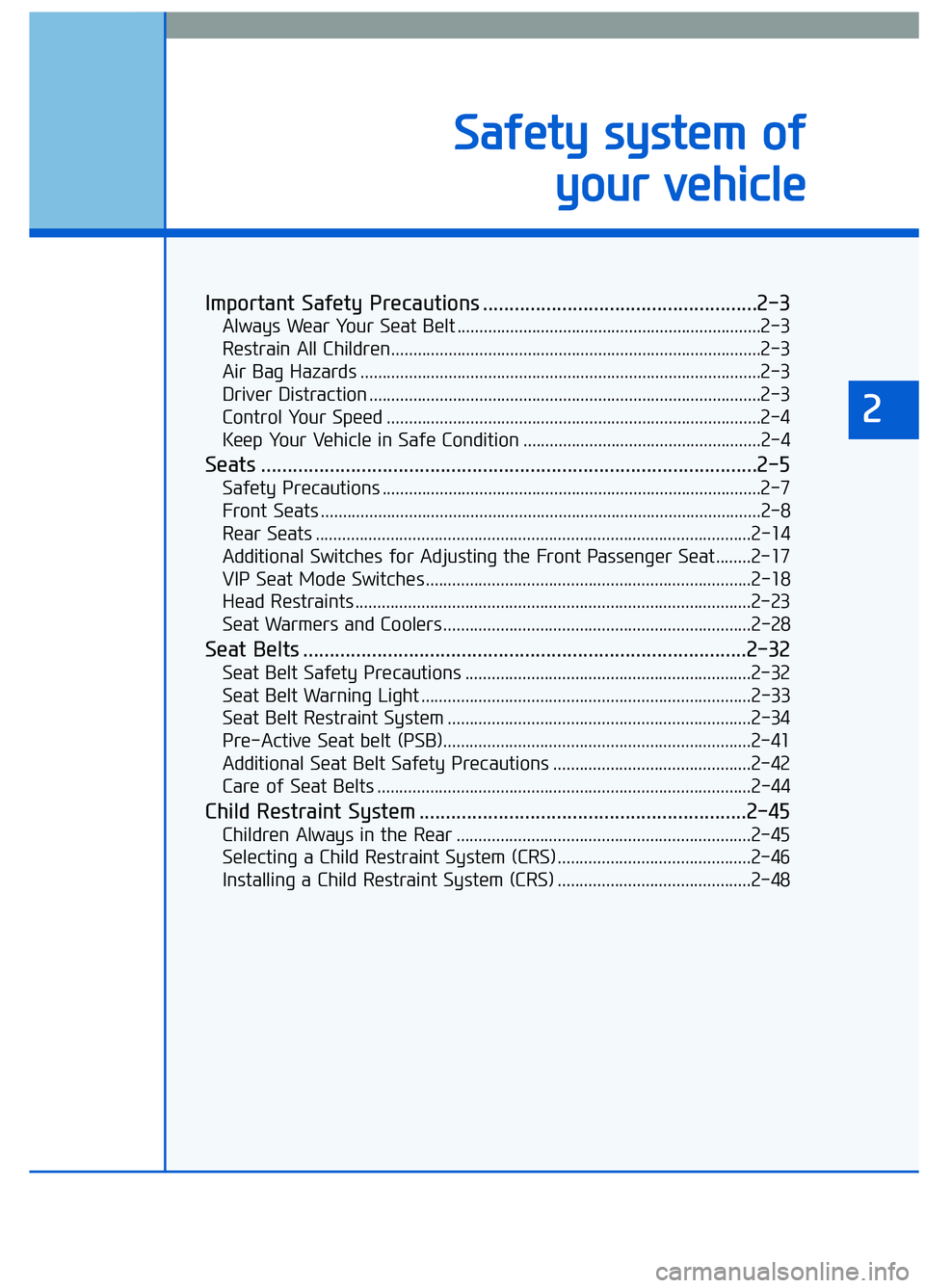
Important Safety Precautions ....................................................2-3
Always Wear Your Seat Belt .....................................................................2-3\
Restrain All Children........................................................................\
............2-3
Air Bag Hazards ........................................................................\
...................2-3
Driver Distraction ........................................................................\
.................2-3
Control Your Speed ........................................................................\
.............2-4
Keep Your Vehicle in Safe Condition ......................................................2-4
Seats ........................................................................\
......................2-5
Safety Precautions ........................................................................\
..............2-7
Front Seats ........................................................................\
............................2-8
Rear Seats ........................................................................\
...........................2-14
Additional Switches for Adjusting the Front Passenger Seat........2-17
VIP Seat Mode Switches ........................................................................\
..2-18
Head Restraints ........................................................................\
..................2-23
Seat Warmers and Coolers ......................................................................2-\
28
Seat Belts ........................................................................\
............2-32
Seat Belt Safety Precautions .................................................................2-32
Seat Belt Warning Light ........................................................................\
...2-33
Seat Belt Restraint System .....................................................................2-3\
4
Pre-Active Seat belt (PSB)......................................................................2-\
41
Additional Seat Belt Safety Precautions .............................................2-42
Care of Seat Belts ........................................................................\
.............2-44
Child Restraint System ..............................................................2-45
Children Always in the Rear ...................................................................2-45
Selecting a Child Restraint System (CRS) ............................................2-46
Installing a Child Restraint System (CRS) ............................................2-48
2
S Sa
af
fe
e t
ty
y
s
s y
y s
st
te
e m
m
o
o f
f
y
y o
o u
ur
r
v
v e
e h
h i
ic
c l
le
e
Page 23 of 524
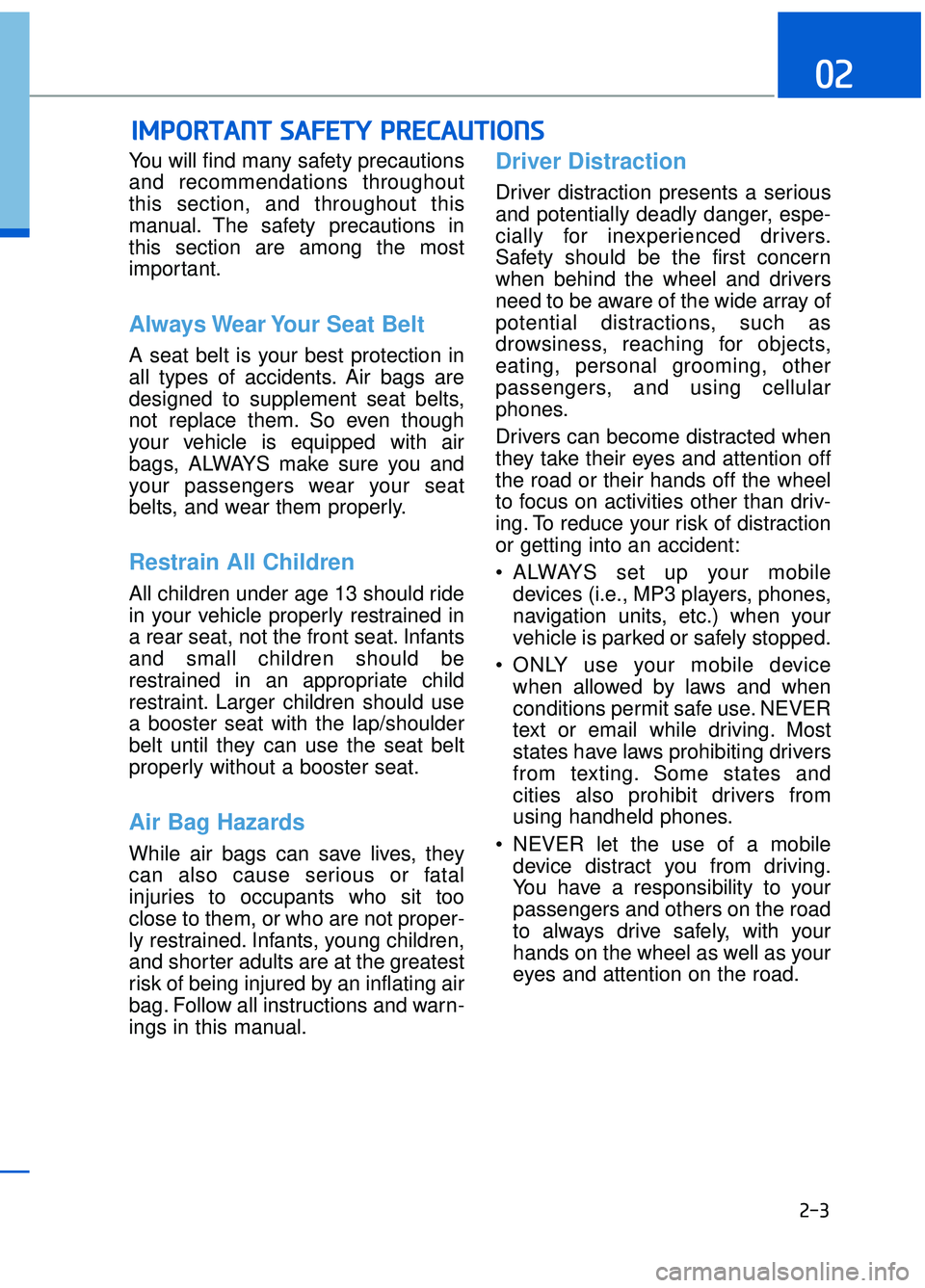
2-3
02
You will find many safety precautions
and recommendations throughout
this section, and throughout this
manual. The safety precautions in
this section are among the most
important.
Always Wear Your Seat Belt
A seat belt is your best protection in
all types of accidents. Air bags are
designed to supplement seat belts,
not replace them. So even though
your vehicle is equipped with air
bags, ALWAYS make sure you and
your passengers wear your seat
belts, and wear them properly.
Restrain All Children
All children under age 13 should ride
in your vehicle properly restrained in
a rear seat, not the front seat. Infants
and small children should be
restrained in an appropriate child
restraint. Larger children should use
a booster seat with the lap/shoulder
belt until they can use the seat belt
properly without a booster seat.
Air Bag Hazards
While air bags can save lives, they
can also cause serious or fatal
injuries to occupants who sit too
close to them, or who are not proper-
ly restrained. Infants, young children,
and shorter adults are at the greatest
risk of being injured by an inflating air
bag. Follow all instructions and warn-
ings in this manual.
Driver Distraction
Driver distraction presents a serious
and potentially deadly danger, espe-
cially for inexperienced drivers.
Safety should be the first concern
when behind the wheel and drivers
need to be aware of the wide array of
potential distractions, such as
drowsiness, reaching for objects,
eating, personal grooming, other
passengers, and using cellular
phones.
Drivers can become distracted when
they take their eyes and attention off
the road or their hands off the wheel
to focus on activities other than driv-
ing. To reduce your risk of distraction
or getting into an accident:
• ALWAYS set up your mobiledevices (i.e., MP3 players, phones,
navigation units, etc.) when your
vehicle is parked or safely stopped.
ONLY use your mobile device when allowed by laws and when
conditions permit safe use. NEVER
text or email while driving. Most
states have laws prohibiting drivers
from texting. Some states and
cities also prohibit drivers from
using handheld phones.
NEVER let the use of a mobile device distract you from driving.
You have a responsibility to your
passengers and others on the road
to always drive safely, with your
hands on the wheel as well as your
eyes and attention on the road.
I IM
M P
PO
O R
RT
TA
A N
N T
T
S
S A
A F
FE
E T
T Y
Y
P
P R
R E
EC
CA
A U
U T
TI
IO
O N
NS
S
Page 27 of 524
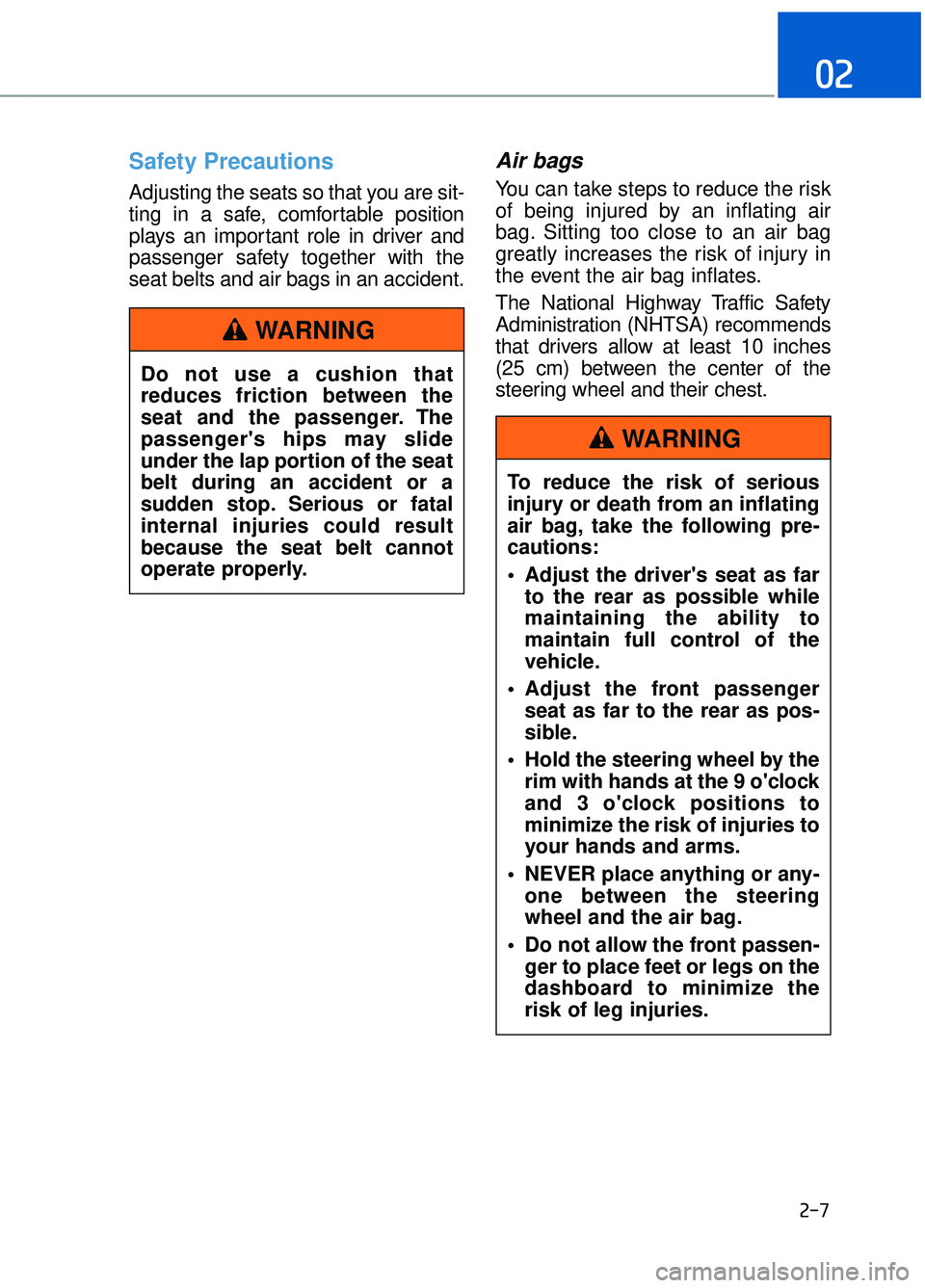
2-7
02
Safety Precautions
Adjusting the seats so that you are sit-
ting in a safe, comfortable position
plays an important role in driver and
passenger safety together with the
seat belts and air bags in an accident.
Air bags
You can take steps to reduce the risk
of being injured by an inflating air
bag. Sitting too close to an air bag
greatly increases the risk of injury in
the event the air bag inflates.
The National Highway Traffic Safety
Administration (NHTSA) recommends
that drivers allow at least 10 inches
(25 cm) between the center of the
steering wheel and their chest.
Do not use a cushion that
reduces friction between the
seat and the passenger. The
passenger's hips may slide
under the lap portion of the seat
belt during an accident or a
sudden stop. Serious or fatal
internal injuries could result
because the seat belt cannot
operate properly.
WARNING
To reduce the risk of serious
injury or death from an inflating
air bag, take the following pre-
cautions:
• Adjust the driver's seat as far
to the rear as possible while
maintaining the ability to
maintain full control of the
vehicle.
Adjust the front passenger seat as far to the rear as pos-
sible.
Hold the steering wheel by the rim with hands at the 9 o'clock
and 3 o'clock positions to
minimize the risk of injuries to
your hands and arms.
NEVER place anything or any- one between the steering
wheel and the air bag.
Do not allow the front passen- ger to place feet or legs on the
dashboard to minimize the
risk of leg injuries.
WARNING
Page 28 of 524
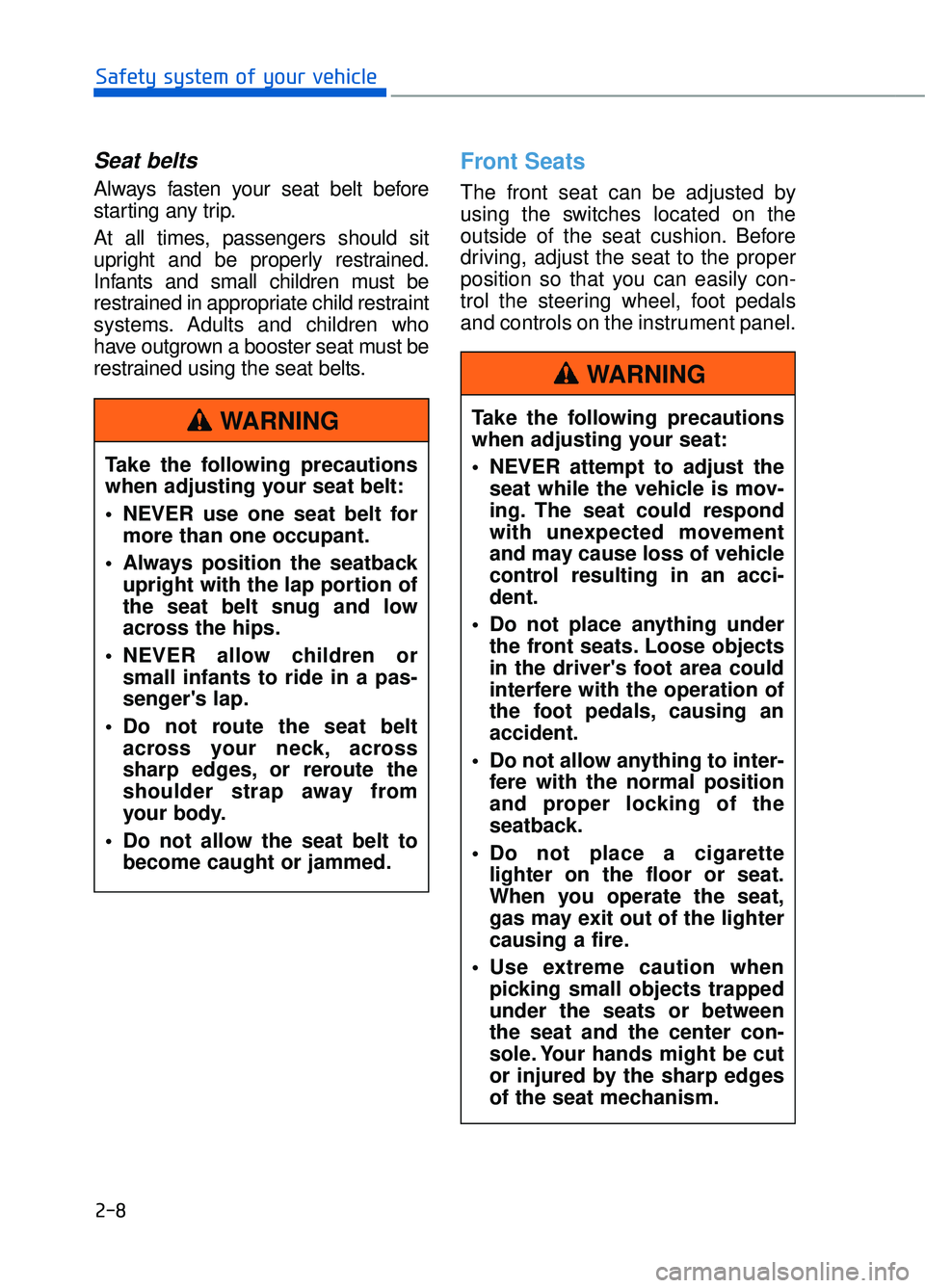
2-8
Safety system of your vehicle
Seat belts
Always fasten your seat belt before
starting any trip.
At all times, passengers should sit
upright and be properly restrained.
Infants and small children must be
restrained in appropriate child restraint
systems. Adults and children who
have outgrown a booster seat must be
restrained using the seat belts.
Front Seats
The front seat can be adjusted by
using the switches located on the
outside of the seat cushion. Before
driving, adjust the seat to the proper
position so that you can easily con-
trol the steering wheel, foot pedals
and controls on the instrument panel.
Take the following precautions
when adjusting your seat belt:
NEVER use one seat belt for more than one occupant.
Always position the seatback upright with the lap portion of
the seat belt snug and low
across the hips.
NEVER allow children or small infants to ride in a pas-
senger's lap.
Do not route the seat belt across your neck, across
sharp edges, or reroute the
shoulder strap away from
your body.
Do not allow the seat belt to become caught or jammed.
WARNINGTake the following precautions
when adjusting your seat:
NEVER attempt to adjust theseat while the vehicle is mov-
ing. The seat could respond
with unexpected movement
and may cause loss of vehicle
control resulting in an acci-
dent.
Do not place anything under the front seats. Loose objects
in the driver's foot area could
interfere with the operation of
the foot pedals, causing an
accident.
Do not allow anything to inter- fere with the normal position
and proper locking of the
seatback.
Do not place a cigarette lighter on the floor or seat.
When you operate the seat,
gas may exit out of the lighter
causing a fire.
Use extreme caution when picking small objects trapped
under the seats or between
the seat and the center con-
sole. Your hands might be cut
or injured by the sharp edges
of the seat mechanism.
WARNING
Page 29 of 524
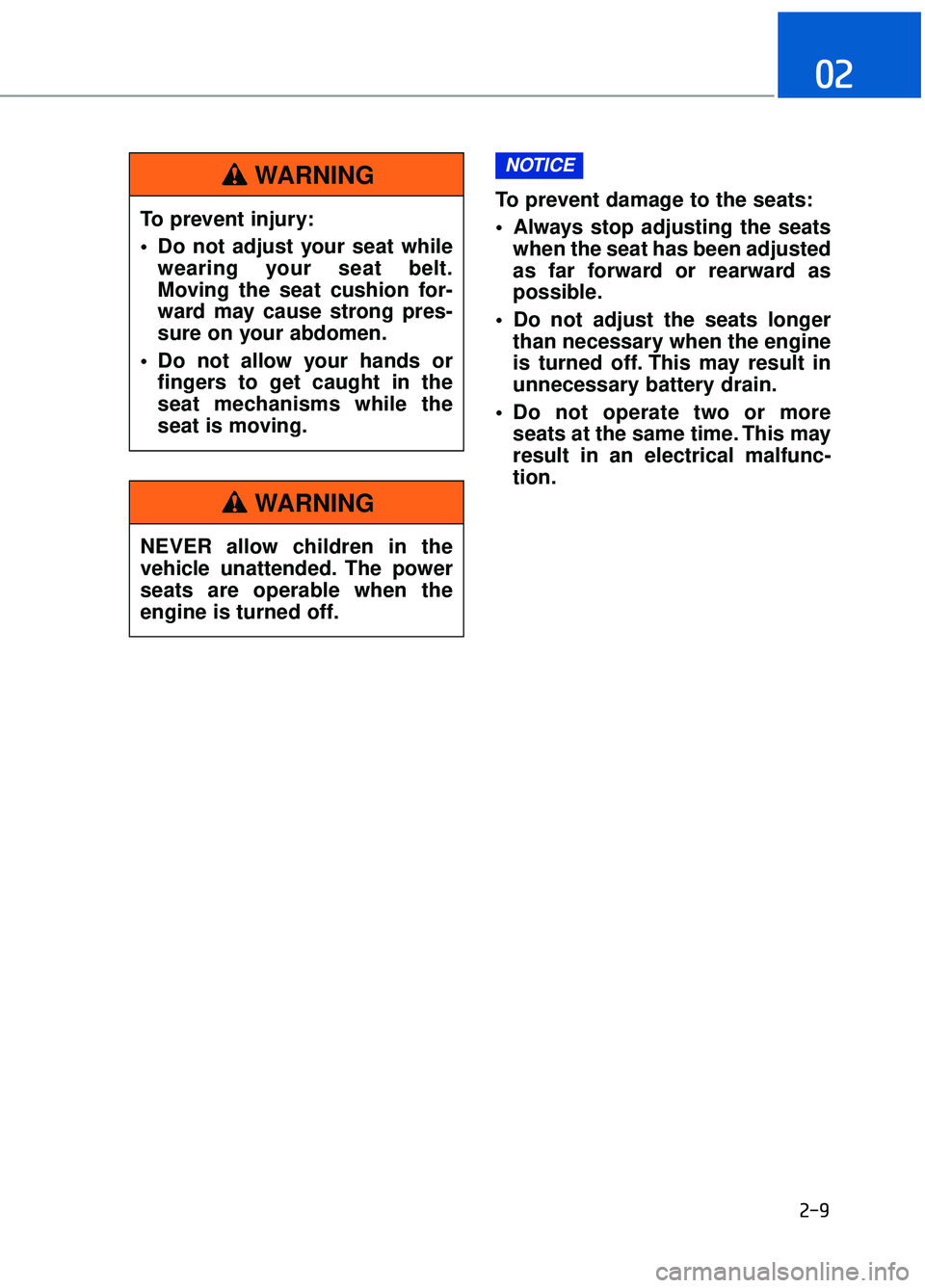
2-9
02
To prevent damage to the seats:
Always stop adjusting the seatswhen the seat has been adjusted
as far forward or rearward as
possible.
Do not adjust the seats longer than necessary when the engine
is turned off. This may result in
unnecessary battery drain.
Do not operate two or more seats at the same time. This may
result in an electrical malfunc-
tion.
NOTICE
To prevent injury:
Do not adjust your seat whilewearing your seat belt.
Moving the seat cushion for-
ward may cause strong pres-
sure on your abdomen.
Do not allow your hands or fingers to get caught in the
seat mechanisms while the
seat is moving.
WARNING
NEVER allow children in the
vehicle unattended. The power
seats are operable when the
engine is turned off.
WARNING
Page 31 of 524
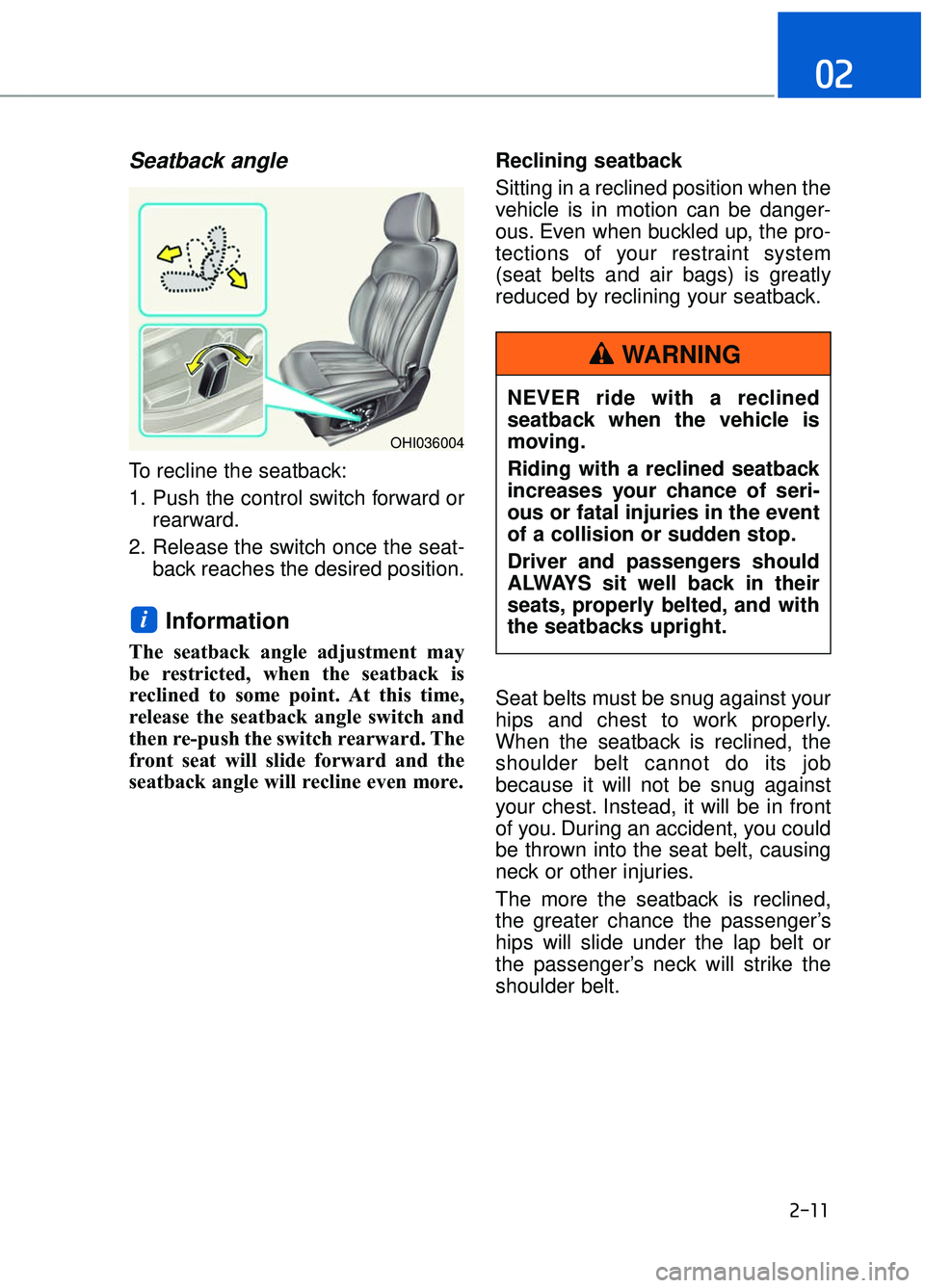
2-11
02
Seatback angle
To recline the seatback:
1. Push the control switch forward orrearward.
2. Release the switch once the seat- back reaches the desired position.
Information
The seatback angle adjustment may
be restricted, when the seatback is
reclined to some point. At this time,
release the seatback angle switch and
then re-push the switch rearward. The
front seat will slide forward and the
seatback angle will recline even more. Reclining seatback
Sitting in a reclined position when the
vehicle is in motion can be danger-
ous. Even when buckled up, the pro-
tections of your restraint system
(seat belts and air bags) is greatly
reduced by reclining your seatback.
Seat belts must be snug against your
hips and chest to work properly.
When the seatback is reclined, the
shoulder belt cannot do its job
because it will not be snug against
your chest. Instead, it will be in front
of you. During an accident, you could
be thrown into the seat belt, causing
neck or other injuries.
The more the seatback is reclined,
the greater chance the passenger’s
hips will slide under the lap belt or
the passenger’s neck will strike the
shoulder belt.
i
OHI036004
NEVER ride with a reclined
seatback when the vehicle is
moving.
Riding with a reclined seatback
increases your chance of seri-
ous or fatal injuries in the event
of a collision or sudden stop.
Driver and passengers should
ALWAYS sit well back in their
seats, properly belted, and with
the seatbacks upright.
WARNING
Page 34 of 524
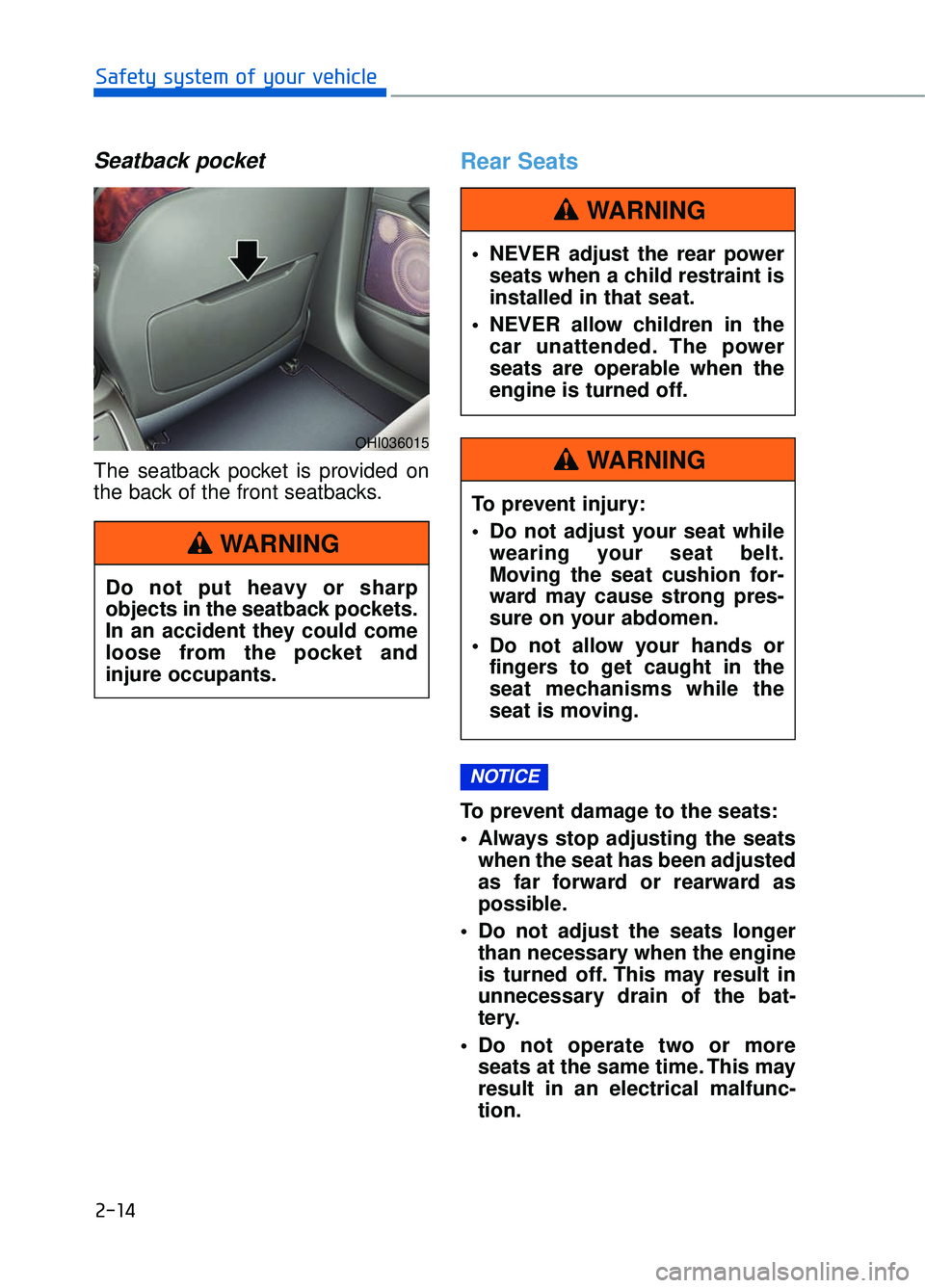
2-14
Safety system of your vehicle
Seatback pocket
The seatback pocket is provided on
the back of the front seatbacks.
Rear Seats
To prevent damage to the seats:
Always stop adjusting the seatswhen the seat has been adjusted
as far forward or rearward as
possible.
Do not adjust the seats longer than necessary when the engine
is turned off. This may result in
unnecessary drain of the bat-
tery.
Do not operate two or more seats at the same time. This may
result in an electrical malfunc-
tion.
NOTICE
NEVER adjust the rear powerseats when a child restraint is
installed in that seat.
NEVER allow children in the car unattended. The power
seats are operable when the
engine is turned off.
WARNING
To prevent injury:
Do not adjust your seat whilewearing your seat belt.
Moving the seat cushion for-
ward may cause strong pres-
sure on your abdomen.
Do not allow your hands or fingers to get caught in the
seat mechanisms while the
seat is moving.
WARNING
OHI036015
Do not put heavy or sharp
objects in the seatback pockets.
In an accident they could come
loose from the pocket and
injure occupants.
WARNING
Page 36 of 524
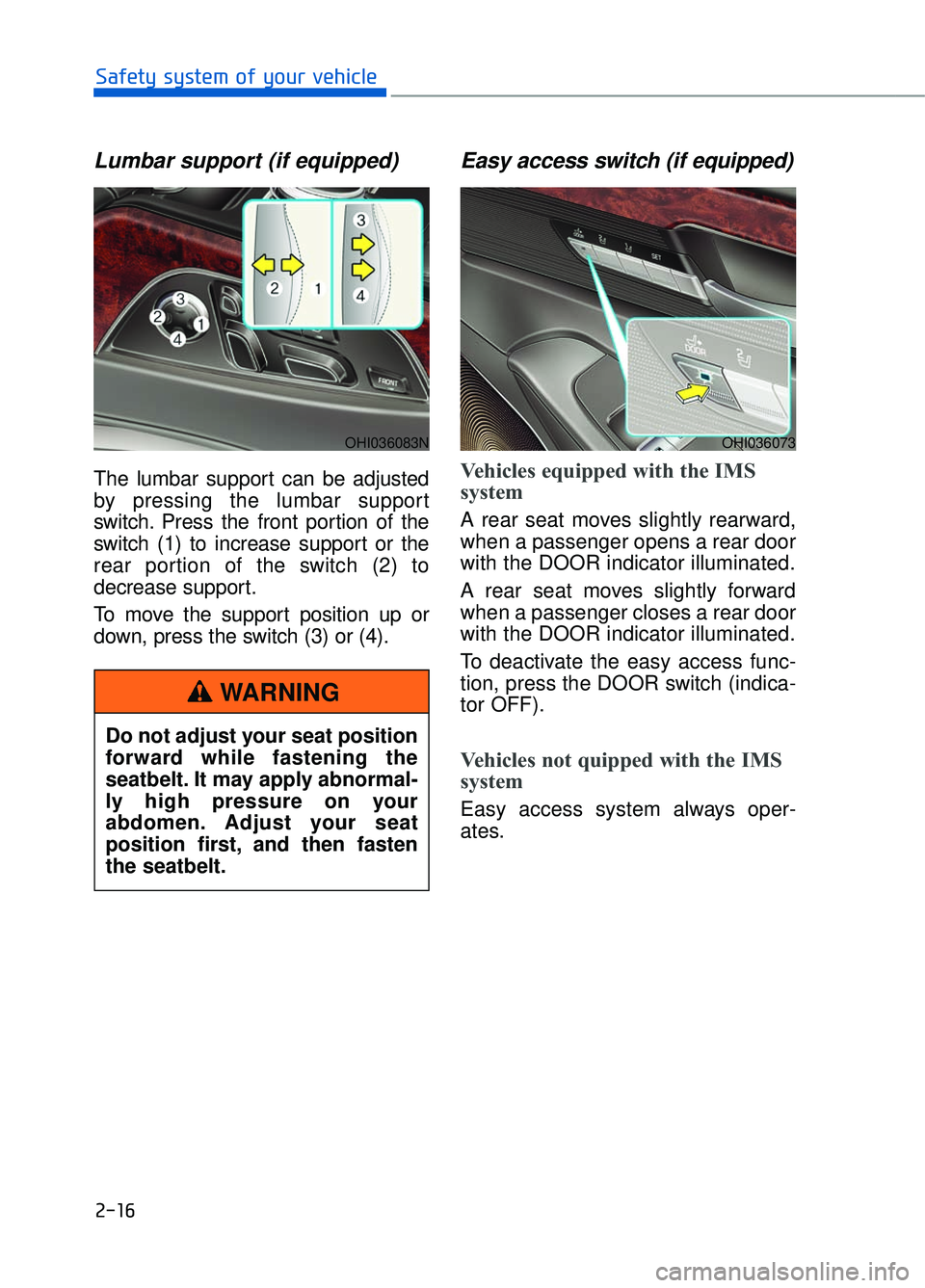
2-16
Safety system of your vehicle
Lumbar support (if equipped)
The lumbar support can be adjusted
by pressing the lumbar support
switch. Press the front portion of the
switch (1) to increase support or the
rear portion of the switch (2) to
decrease support.
To move the support position up or
down, press the switch (3) or (4).
Easy access switch (if equipped)
Vehicles equipped with the IMS
system
A rear seat moves slightly rearward,
when a passenger opens a rear door
with the DOOR indicator illuminated.
A rear seat moves slightly forward
when a passenger closes a rear door
with the DOOR indicator illuminated.
To deactivate the easy access func-
tion, press the DOOR switch (indica-
tor OFF).
Vehicles not quipped with the IMS
system
Easy access system always oper-
ates.
Do not adjust your seat position
forward while fastening the
seatbelt. It may apply abnormal-
ly high pressure on your
abdomen. Adjust your seat
position first, and then fasten
the seatbelt.
WARNING
OHI036083NOHI036073
Page 37 of 524
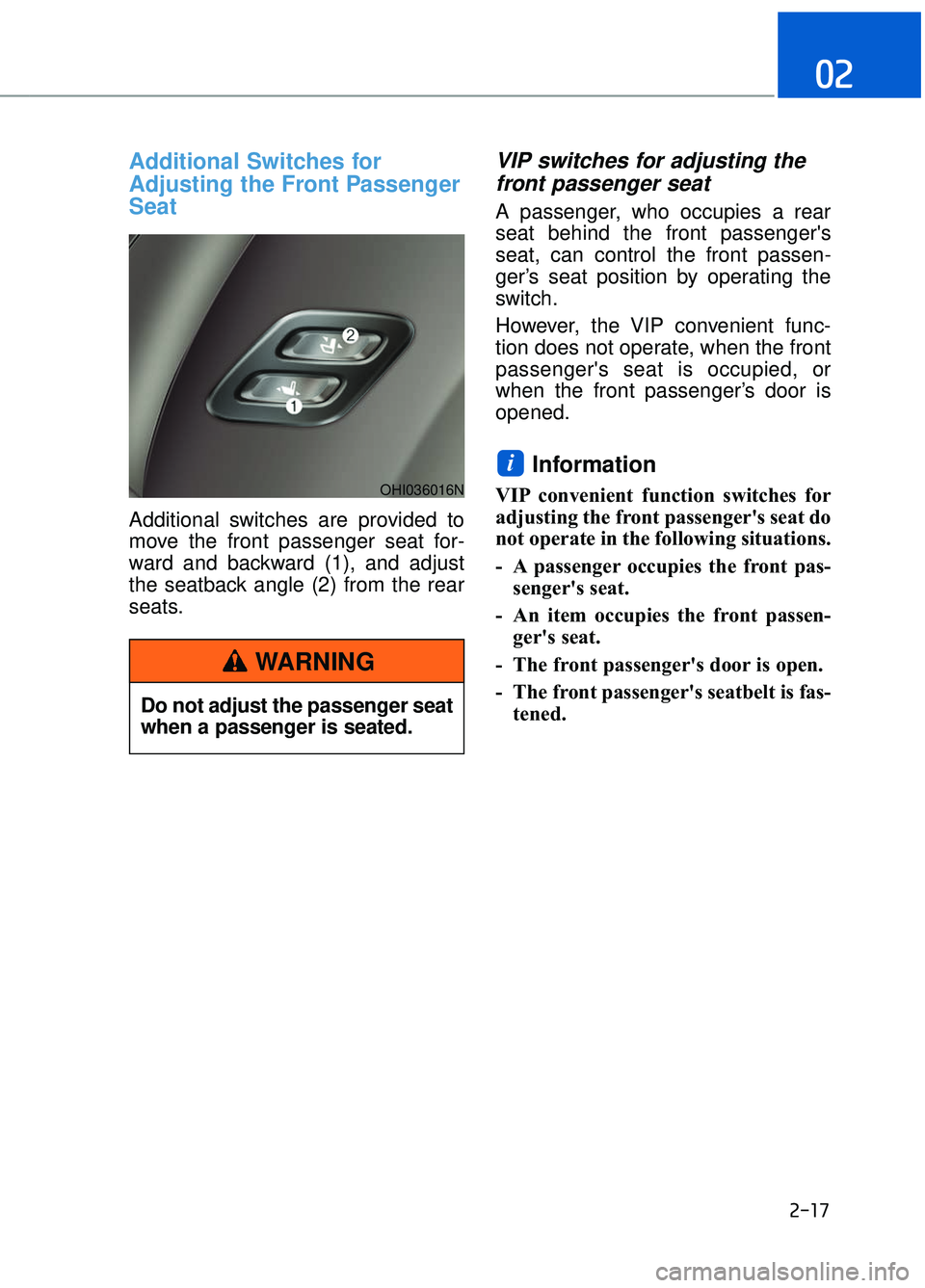
2-17
02
Additional Switches for
Adjusting the Front Passenger
Seat
Additional switches are provided to
move the front passenger seat for-
ward and backward (1), and adjust
the seatback angle (2) from the rear
seats.
VIP switches for adjusting thefront passenger seat
A passenger, who occupies a rear
seat behind the front passenger's
seat, can control the front passen-
ger’s seat position by operating the
switch.
However, the VIP convenient func-
tion does not operate, when the front
passenger's seat is occupied, or
when the front passenger’s door is
opened.
Information
VIP convenient function switches for
adjusting the front passenger's seat do
not operate in the following situations.
- A passenger occupies the front pas-
senger's seat.
- An item occupies the front passen- ger's seat.
- The front passenger's door is open.
- The front passenger's seatbelt is fas- tened.
i
OHI036016N
Do not adjust the passenger seat
when a passenger is seated.
WARNING
Page 39 of 524
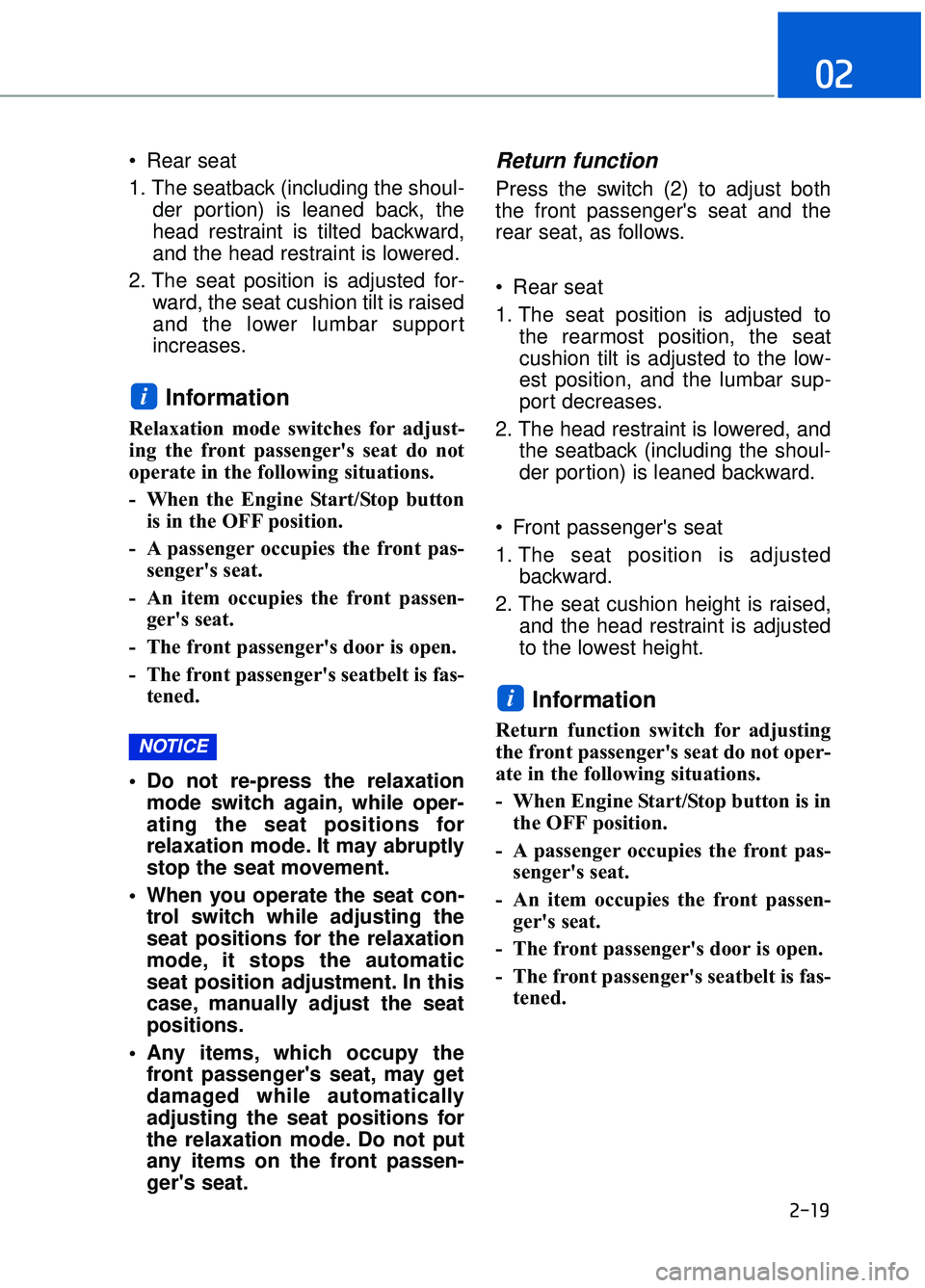
2-19
02
Rear seat
1. The seatback (including the shoul-der portion) is leaned back, the
head restraint is tilted backward,
and the head restraint is lowered.
2. The seat position is adjusted for- ward, the seat cushion tilt is raised
and the lower lumbar support
increases.
Information
Relaxation mode switches for adjust-
ing the front passenger's seat do not
operate in the following situations.
- When the Engine Start/Stop buttonis in the OFF position.
- A passenger occupies the front pas- senger's seat.
- An item occupies the front passen- ger's seat.
- The front passenger's door is open.
- The front passenger's seatbelt is fas- tened.
Do not re-press the relaxation mode switch again, while oper-
ating the seat positions for
relaxation mode. It may abruptly
stop the seat movement.
When you operate the seat con- trol switch while adjusting the
seat positions for the relaxation
mode, it stops the automatic
seat position adjustment. In this
case, manually adjust the seat
positions.
Any items, which occupy the front passenger's seat, may get
damaged while automatically
adjusting the seat positions for
the relaxation mode. Do not put
any items on the front passen-
ger's seat.
Return function
Press the switch (2) to adjust both
the front passenger's seat and the
rear seat, as follows.
Rear seat
1. The seat position is adjusted to the rearmost position, the seat
cushion tilt is adjusted to the low-
est position, and the lumbar sup-
port decreases.
2. The head restraint is lowered, and the seatback (including the shoul-
der portion) is leaned backward.
Front passenger's seat
1. The seat position is adjusted backward.
2. The seat cushion height is raised, and the head restraint is adjusted
to the lowest height.
Information
Return function switch for adjusting
the front passenger's seat do not oper-
ate in the following situations.
- When Engine Start/Stop button is inthe OFF position.
- A passenger occupies the front pas- senger's seat.
- An item occupies the front passen- ger's seat.
- The front passenger's door is open.
- The front passenger's seatbelt is fas- tened.
i
NOTICE
i